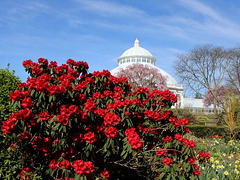Don Sutherland's photos
Bringing Joy
| |
|
|
|
Tulips at the New York Botanical Garden (Bronx, New York)—April 27, 2024. Irish poet Oscar Wilde once observed, “A flower blossoms for its own joy.” He might well have continued about how generously flowers share their beauty to create a more colorful and joyful world.
Bleeding Hearts
| |
|
|
|
Bleeding hearts at the New York Botanical Garden (Bronx, New York)—April 21, 2024
Jonquilla Daffodils
| |
|
|
|
Jonquilla daffodils (Narcissus ‘Pipit’) at the New York Botanical Garden (Bronx, New York)—April 21, 2024
Spring Fire
| |
|
|
|
Detail of a poppy at the New York Botanical Garden (Bronx, New York)—April 21, 2024. Shirley Hibberd’s Familiar Garden Flowers wrote of poppies as follows: “No more interesting flower is to be found in the garden than the poppy, and a certain few kinds are extravagantly beautiful, though lamentably short-lived.” One of those “certain few kinds” of poppies is the “blazing red poppy” that, when present in large numbers, “suggests that we are riding through…seas of fire…”
Gentle April Breath
| |
|
|
|
Tulips at the New York Botanical Garden (Bronx, New York)—April 21, 2024. The soft images illustrate what American poet Ellen Clementine Howarth described as the "gentle April breath." The beauty of this pair of tulips is but one of the main courses of Spring's three-month long feast for the eyes. The original photo was processed to soften the detail and slightly fade the tulip’s colors allowing the pestle to stand out to symbolize the beating heart of spring.
Poet’s Narcissi
| |
|
|
|
Poet’s Narcissi at the New York Botanical Garden (Bronx, New York)—April 14, 2024. The Garden’s growing multitude of daffodils is now dancing in the spotlight of the strengthening spring sun to the tune of spring’s warm breezes, even as the first daffodils arrived much earlier.
Narcissi have long served as a courageous Messenger of spring that, as Shakespeare observed, “come before the swallow dares.” They have also been described as holding onto their remarkable beauty throughout the duration of their lives. Toward that end, British writer Percy Bysshe Shelley wrote:
And Narcissi, the fairest among them all,
Who gaze on their eyes in the stream’s recess,
Till they die of their own dear loveliness.
Spring
| |
|
|
|
Spring scene at the New York Botanical Garden with the Enid A. Haupt Conservatory in the background (Bronx, New York)—April 14, 2024
Total Solar Eclipse
| |
|
|
|
Purkinje Effect during the 2024 total solar eclipse (Moose River/Jackman, Maine area)—April 8, 2024. Under this phenomenon, peak luminance shifts toward the blue end of the color spectrum. One can visibly see this shift at the Moon’s border.
Slowly, surely, as we sat [on the summit of Pike’s Peak in Colorado] watching, the moon crept on. The light of the Sun grew pale and gray. All yellow rays seemed to fade out of it, and the face of nature and of man took on a ghastly pallor. Two or three minutes before the totality of the eclipse the whole landscape before us was bathed in this cold white light. Then the gloom began to shroud the mountain tops—peak after peak was lost in shadow, and when it reached the plain it seemed to become a solid, palpable body of darkness, rising up in a great wall—not creeping, but rushing on with might and power… The face of the Sun was veiled. The heavens were dark…
—Mrs. Aubrey H. Smith’s description of the July 29, 1878 total solar eclipse
More than a century later, my observation bore remarkable similarity to the above account. By 2 pm EDT, as the onset of the solar eclipse neared, all of the earlier high clouds that had made passage across the sky had vanished. The sky had become perfectly clear in all directions. A gusty breeze had increased in strength.
At 2:18:55 pm, the Moon began cross the plane of the Sun and the eclipse got underway. The temperature began to fall and the wind picked up. Within a few minutes of Totality, the Sunlight grew noticeably dimmer.
Totality commenced at 3:29:50 pm. It was as if one turned off a light at night, instantly plunging oneself into darkness. The gathered people immediately fell silent, creating the impression that the Sun’s light had been the source of their energy. The previously stiff breeze seemed to die off. The temperature grew noticeably cooler from the loss of solar insolation and rapid onset of strong radiational cooling. The air was stripped of its remaining warmth.
Even as the crowd was connected in the experience, the reality that the Earth is little more than a speck in the seemingly endless ocean of an ever-expanding Universe became apparent. One was powerfully reminded that human society for all of its achievements and ambitions is still very small on a Cosmic scale.
During the mid-afternoon darkness, celebratory fireworks were launched in the distance. Although out-of-sight, their sound reverberated across the landscape.
As the total eclipse continued, it seemed that the passage of time itself had been suspended. One need not feel rushed to take in the celestial show. A giant prominence was visible near the bottom of the Moon’s shadow where its silhouette gave way to the white glow of the Sun’s corona.
For 3 minutes and 26.7 seconds, the Moon eclipsed the entirety of the Sun. Once the Sun burst free from behind the retreating Moon’s shadow, the gathered people erupted in applause. The brief but dazzling astronomical performance would leave lifelong memories.
Back to the Mid-Pliocene
| |
|
|
|
AI-generated image: With CO2 now exceeding 420 PPM, humanity is leaving the Holocene and returning to the Mid-Pliocene warm period. Glacial erratics provide reminders of the ice sheets that once existed. Rising seas have claimed land. Tropical plants have migrated northward. The world is a vastly different one from which modern humans evolved, proliferated, and prospered.
Despite overwhelming scientific evidence concerning climate change and its causes and growing urgency for humanity to choose a safer climatic future, COP 28 failed to adopt even minimal targets for curbing and reducing the fossil fuel emissions driving climate change. Despite bold rhetoric about addressing climate change, the United States became the world's largest oil and gas producer on record. Both outcomes are a de facto choice to take humanity into a climate that has not been seen since the Mid-Pliocene period, which was 1.8°C-3.6°C (3.2°F-6.5°F) warmer than the pre-industrial climate. Then, seas peaked at 25 meters above current levels. Those outcomes represent an unspoken but real down payment toward sacrificing some of the world's great coastal metropolises—Amsterdam, Bangkok, Jakarta, Lagos, London,New York, and Tokyo—to Neptune for only human misery in return.
Orchids
| |
|
|
|
Orchids at the New York Botanical Garden’s 2024 Orchid Show (Bronx, New York)—March 24, 2024
Orchids
| |
|
|
|
At the New York Botanical Garden’s 2024 annual orchid show (Bronx, New York)—March 24, 2024.
Bagful of Orchids
| |
|
|
|
At the New York Botanical Garden’s 2024 annual orchid show (Bronx, New York)—March 12, 2024.
Rose-Tinted Glasses
| |
|
|
|
A mannequin views the beauty of the world through designer rose-tinted glasses. The New York Botanical Garden's 2024 Orchid Show (Bronx, New York)—February 25, 2024
Carrying Beauty
| |
|
|
|
Mannequin with a handbag and slipper orchid at the New York Botanical Garden's 2024 Orchid Show (Bronx, New York)—February 25, 2024.
Orchid Show: Florals in Fashion
| |
|
|
|
The New York Botanical Garden’s annual orchid show (Bronx, New York)—February 25, 2024.“The Orchid Show: Florals in Fashion” is inspired by fashion. The Garden’s description states:
Strike a pose! The Orchid Show brings the catwalk to the Enid A. Haupt Conservatory in a fashion-inspired celebration of all things orchids—and we want YOU at the center of the sartorial experience. Catch the bold new designs of New York’s rising stars of the stitch with work by Collina Strada by Hillary Taymour, Dauphinette by Olivia Cheng, and FLWR PSTL by Kristen Alpaugh, fashionistas who have created dramatic, picture-perfect floral displays at the Garden that always capture the orchid’s good side. This is your chance to “walk the runway” and show off your own personal flair, your love for orchids, and your fashion-forward connections to the natural world. Because florals are always en vogue at NYBG.
Snowstorm
| |
|
|
|
A snowstorm blankets the landscape (Larchmont, New York)—February 13, 2024. The storm brought 3.2" (8.1 cm) of snow. Overall, the season has been characterized by much below normal snowfall. Through today, seasonal snowfall is 7.5" (19.1 cm). Last winter saw the least snowfall on record with just 2.3" (5.8 cm). New York City went through a record 701-day stretch without seeing daily snowfall of 1.0" (2.5 cm) or more. The old record was 383 days.
Should New York City finish with less than 10.0" (25.4 cm) of snow, Winters 2022-2023 and 2023-2024 would mark the first time two consecutive winters had less than 10.0" (25.4 cm) of snow. (The snow season ends on June 30th, although New York City has never seen measurable snowfall after April 25th. Normal snowfall is 29.8" (75.7 cm).
In terms of temperatures, Winter 2023-2024 is concluding today with a seasonal average temperature of 40.6°F (4.8°C) in New York City. That is its fourth warmest winter on record. The past two winters have become the first occurence of two consecutive winters having average temperatures of 40.0°F (4.4°C) or warmer in New York City. Such winters were once rare. Prior to 2000, only one winter, 1931-1932, had a mean temperature of 40.0°F (4.4°C) or above. Since then five winters have seen such warmth: 2001-2002, 2011-2012, 2015-2016, 2022-2023, and 2023-2024. New York City's records go back to 1869.
Many locations experienced their warmest winter on record. Much of Canada, the Northern Plains in the United States, parts of Europe, and northwest Africa saw extraordinary warmth. Scandinavia was one of the few places that had a colder than normal winter.
Overall, it seemed that autumn lingered through the winter months giving up only its glorious colors, but not much of its warmth. Now, the early flowers of spring already dot the landscape.
Pondering the Universe
| |
|
|
|
AI visualization: A young cosmologist ponders the origin and development of the Universe from her seat in the cosmos as space-time curves beneath her feet and Earth comes into view behind her.
Playing Dangerously
| |
|
|
|
AI generation: A pianist plays with one hand during a moonlit night while a nearby volcano explodes. The image represents humanity’s largely business-as-usual course even as rising greenhouse gases lead to severe heatwaves, intense precipitation, severe droughts, and widespread marine heatwaves. The use of a single hand symbolizes humanity’s less than full effort to address climate change. The erupting volcano warns of the dangers that lie ahead. The full Moon and clear night sky represent the flourishing world that is fast disappearing.
Jump to top
- ipernity © 2007-2024
- Help & Contact
|
Club news
|
About ipernity
|
History |
ipernity Club & Prices |
Guide of good conduct
Donate | Group guidelines | Privacy policy | Terms of use | Statutes | In memoria -
Facebook
Twitter


















